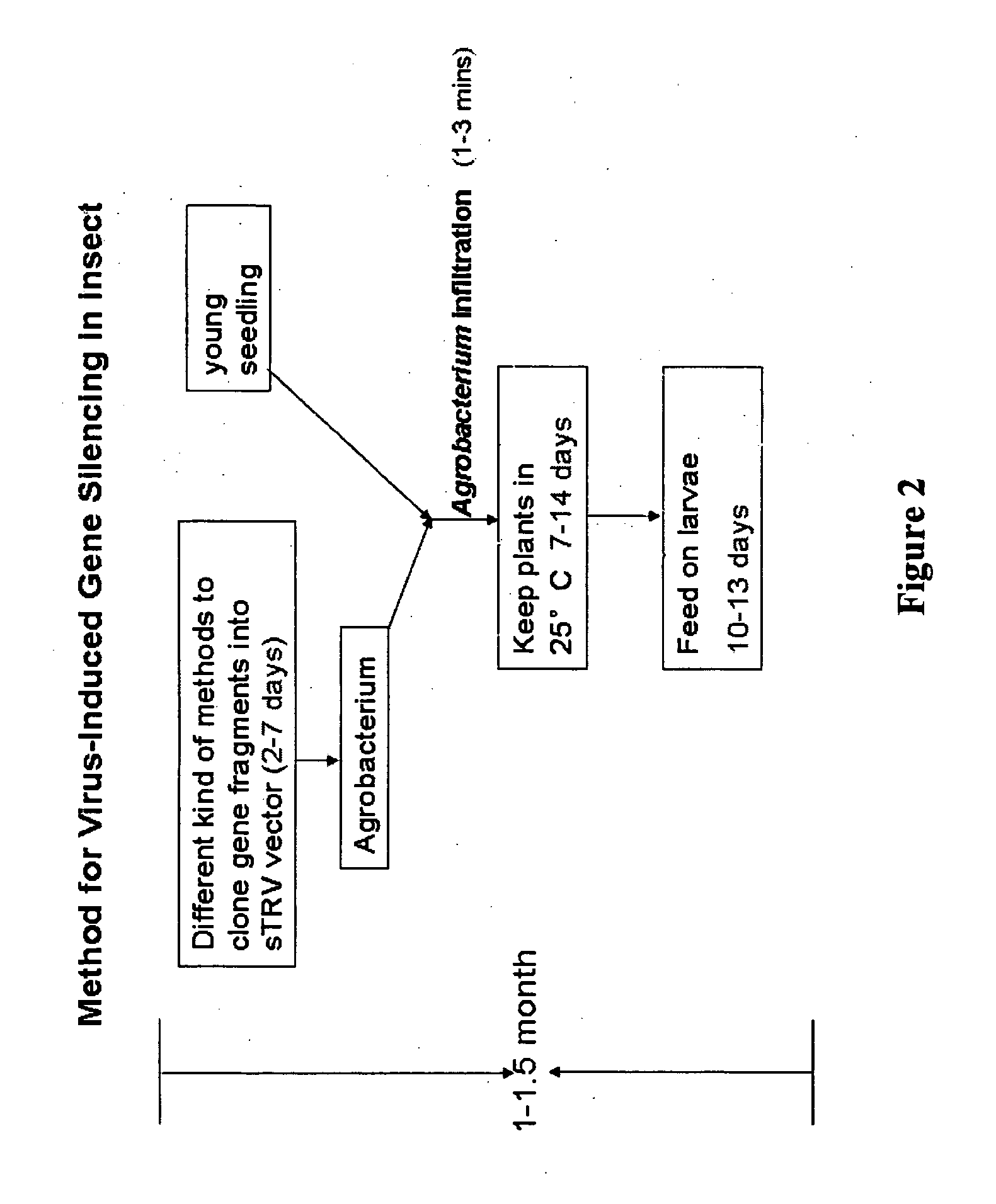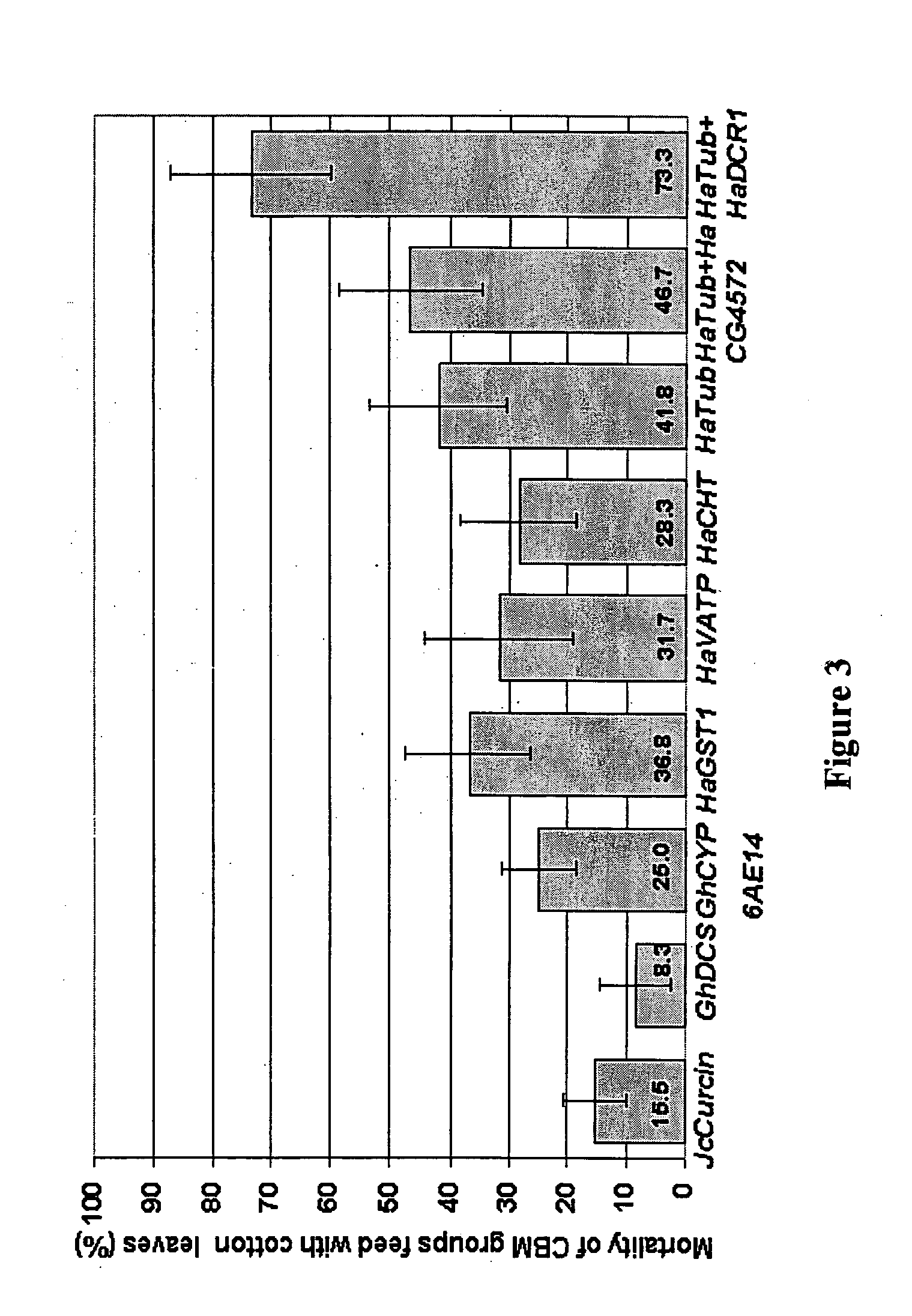Control of pests in plants
a technology for controlling pests and plants, applied in the field of controlling pests, can solve the problems of chemical pesticidal agents persisting in the environment, commercial crops are often targets, and the metabolization of chemical pesticidal agents is slow,
- Summary
- Abstract
- Description
- Claims
- Application Information
AI Technical Summary
Benefits of technology
Problems solved by technology
Method used
Image
Examples
example 1
Experimental Procedures
[0091]Plant Seedlings:
[0092]Tobacco (Nicotiana benthamiana) and cotton (Gossypium hirsutum L. cv. Coker 312) seeds were propagated in Singapore and were germinated in a greenhouse. Plants of tobacco and cotton were grown in presterilized soil at 25° C. on a 16-h-day / 8-h-night cycle. Tobacco seedlings with 3-5 true leaves were used for agroinjection and cotton seedlings with 2-3 true leaves were used for vacuum infiltration.
[0093]Cotton Bollworm:
[0094]Cotton bollworm (Helicoverpa armigera) eggs were obtained from Chinese Academy of Agricultural Sciences and reared in the laboratory at 25° C. and 70% relative humidity on a 14-h-day / 10-h-night cycle. The larvae were fed on a modified artificial diet as described. Leaves of tobacco plants (1-2 weeks post-agroinjection) or cotton plants (2-3 weeks post vacuum-infiltration) were used for feeding experiments. For each feeding experiment, synchronous larvae were selected, weighed individually and divided into groups; ...
example 2
Identification of Insect Target Sequence
[0106]This example illustrates the identification of nucleotide sequences that, when inserted into the VIGS vector to produce recombinant virus replicating in the host plants, which can be a diet of a cotton bollworm (CBM), are useful for controlling a CBM species insect pest. This example shows that the VIGS system can be used to rapidly screen for genes useful for controlling insects with RNAi technology.
[0107]Insect P450 monooxygenases play a central role in adaptation to plant defense compounds and in developing insecticide resistance. Cotton bollworm requires an elevated level of a gossypol-induced cytochrome P450 (HaCYP6AE14) to detoxify gossypol when they grow on cotton, downregulation of HaCYP6AE14 might reduce larval tolerance of gossypol if larvae are fed plant material that expresses VIGS vector against a target of interest.
[0108]A CYP6AE14 gene coding sequence derived from GenBank was used to construct a nucleotide sequence encodin...
example 3
Identification of Insect Target Sequence
[0111]This example illustrates the identification of nucleotide sequences that, when inserted into the VIGS vector produces recombinant virus replicating in the host plants, which can be a diet of a cotton bollworm, are useful for controlling a cotton bollworm species insect pest.
[0112]Bio-energy metabolism pathway of eukaryotic systems is a basal and essential function for living organism. The vacuolar H+-ATPase (V-ATPase) is one of the most fundamental enzymes in nature. It functions in maintaining sufficient levels of ATP in almost every eukaryotic cell and energizes a wide variety of organelles and membranes. Null mutations in genes encoding V-ATPase subunits are likely to be lethal for most eukaryotic cells because primary energization of the vacuolar system by this enzyme drives vital secondary transport processes across membranes of vacuolar-derived organelles. Disruption of genes encoding V-ATPase subunits in Drosophila is also lethal....
PUM
| Property | Measurement | Unit |
|---|---|---|
| resistance | aaaaa | aaaaa |
| chemical compositions | aaaaa | aaaaa |
| chemical | aaaaa | aaaaa |
Abstract
Description
Claims
Application Information
 Login to View More
Login to View More - R&D
- Intellectual Property
- Life Sciences
- Materials
- Tech Scout
- Unparalleled Data Quality
- Higher Quality Content
- 60% Fewer Hallucinations
Browse by: Latest US Patents, China's latest patents, Technical Efficacy Thesaurus, Application Domain, Technology Topic, Popular Technical Reports.
© 2025 PatSnap. All rights reserved.Legal|Privacy policy|Modern Slavery Act Transparency Statement|Sitemap|About US| Contact US: help@patsnap.com



